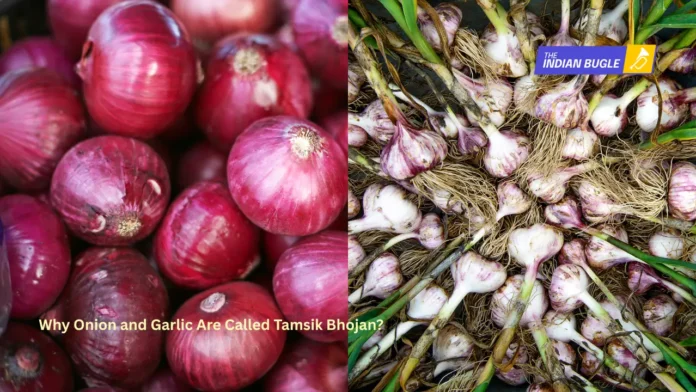Onion and garlic — staples in kitchens across the world — are loved for their flavor and powerful health benefits. Yet, in Indian spiritual traditions, these two ingredients are often labeled as “Tamsik Bhojan” (तामसिक भोजन), meaning foods that promote darkness, ignorance, or lethargy of the mind.
This classification, deeply rooted in Ayurveda, yogic philosophy, and Hindu scriptures, goes beyond taste or nutrition — it connects food to emotion, energy, and consciousness. Let’s explore why onion and garlic are viewed this way, along with their fascinating evolutionary history.
The Three Gunas: Sattva, Rajas, and Tamas
In Indian philosophy, every food item influences the human mind and body according to three basic qualities known as Gunas — Sattva (purity), Rajas (passion), and Tamas (darkness).
| Guna | Nature | Impact on Mind | Common Foods |
| Sattvik | Pure, light, balanced | Promotes peace, clarity, compassion | Fruits, grains, milk, ghee, honey |
| Rajasic | Stimulating, spicy | Increases activity, restlessness, ambition | Spices, coffee, fried food |
| Tamasik | Heavy, dulling, decaying | Creates lethargy, ignorance, confusion | Meat, alcohol, onions, garlic |
Foods are thus not only judged by their nutritional value, but also by their energetic vibration and their influence on one’s state of consciousness.
Why Onion and Garlic Are Called Tamsik Bhojan
1. They Affect the Mind and Emotions
According to yogic beliefs, onions and garlic stimulate the senses and excite base emotions like anger, lust, and anxiety. For those who practice meditation or spiritual discipline, such foods are believed to disturb mental peace and lower concentration.
2. They Carry Heavy, Grounding Energy
Both onion and garlic grow underground, absorbing dense, earthy energies. This symbolic association with darkness and heaviness contributes to their classification as Tamsik. In yogic terms, they are said to block the free flow of prana (life energy) in the body.
3. They Have a Strong Odour and Pungency
The intense smell and flavor of onions and garlic overstimulate the nervous system. This is why monks, yogis, and practitioners of meditation avoid them, aiming instead for a Sattvik diet that keeps the mind serene and detached.
4. Scriptural References
The Bhagavad Gita (Chapter 17, Verse 8–10) classifies foods that are stale, impure, and foul-smelling as Tamsik. Similarly, Ayurvedic texts and Vaishnav traditions discourage the use of onions and garlic in spiritual meals, temple offerings, or during fasting.
In Jainism, these foods are also avoided because uprooting them kills the entire plant — considered a form of violence (hinsa).
The Ayurvedic View: Medicine or Tamsik?
Interestingly, Ayurveda offers a balanced view. While spiritually they are Tamsik, medicinally they are highly beneficial.
Health Benefits of Onion and Garlic:
- Boost immunity and digestion
- Help fight infections due to natural antibacterial properties
- Reduce cholesterol and blood pressure
- Act as natural detoxifiers
Ayurveda thus acknowledges that purpose matters — a yogi may avoid them for mental clarity, but a healer may recommend them for physical wellness.
Evolution of Onion and Garlic: From Ancient Roots to Modern Kitchens
Origin of Garlic (Allium sativum)
Garlic is believed to have originated in Central Asia, particularly in regions that are now part of Iran and Turkmenistan. It was cultivated over 5,000 years ago, with evidence of use in ancient Egyptian, Babylonian, Greek, and Chinese civilizations.
- The Egyptians fed garlic to workers building the pyramids to boost stamina.
- The Greeks and Romans used it as medicine and a warrior’s strength tonic.
- Over centuries, garlic spread across the world and became a core spice in global cuisines.
Origin of Onion (Allium cepa)
Onions trace their origins to Central Asia and the Middle East, with ancient texts suggesting cultivation in Iran and Pakistan nearly 7,000 years ago.
- The Egyptians considered onions sacred symbols of eternity (their circular layers represented eternal life).
- Ancient Indians used onions as both food and medicine — even mentioned in early Ayurvedic formulations.
- Eventually, onions became a global kitchen essential, valued for their flavor, nutrition, and versatility.
How Onion and Garlic Came to India
Both onions and garlic reached India through ancient trade networks – the Silk Route and Indo-Persian exchanges around 2000–1500 BCE.
- Aryan migrations and Persian traders are believed to have introduced these Allium plants to the Indian subcontinent.
- Ancient texts like the Charaka Samhita (Ayurvedic classic) mention lasuna (garlic) and palandu (onion) as potent herbal medicines — evidence that they were known in India well before the Common Era.
By the Mauryan period (around 300 BCE), both onion and garlic were common in Indian households but avoided in temple food and Brahmin diets due to their Tamsik classification.
Over time, Mughal influences and Persian cuisines helped popularize their use in North Indian cooking, especially in curries and gravies.
Today, they are essential in Indian cuisine — yet still excluded in Sattvik or festival foods.
Balancing Science and Spirituality
Today, onions and garlic are essential in most cuisines due to their flavor, health value, and culinary versatility. Yet, the spiritual classification of Tamsik Bhojan continues to hold significance for those pursuing meditation, yoga, or sattvik living.
The key lies in balance and awareness — understanding how food affects not just the body, but also the mind, mood, and energy.
Conclusion
Onion and garlic, being labeled Tamsik Bhojan, are not about superstition but about energy, emotion, and consciousness. These foods, while medicinally beneficial, are thought to disturb inner stillness and heighten sensory desires, making them less suitable for spiritual seekers.
Yet, they remain an integral part of human evolution — from ancient healing herbs to modern culinary treasures.
Ultimately, whether one chooses to include or avoid them depends on one’s purpose — health or higher awareness.
